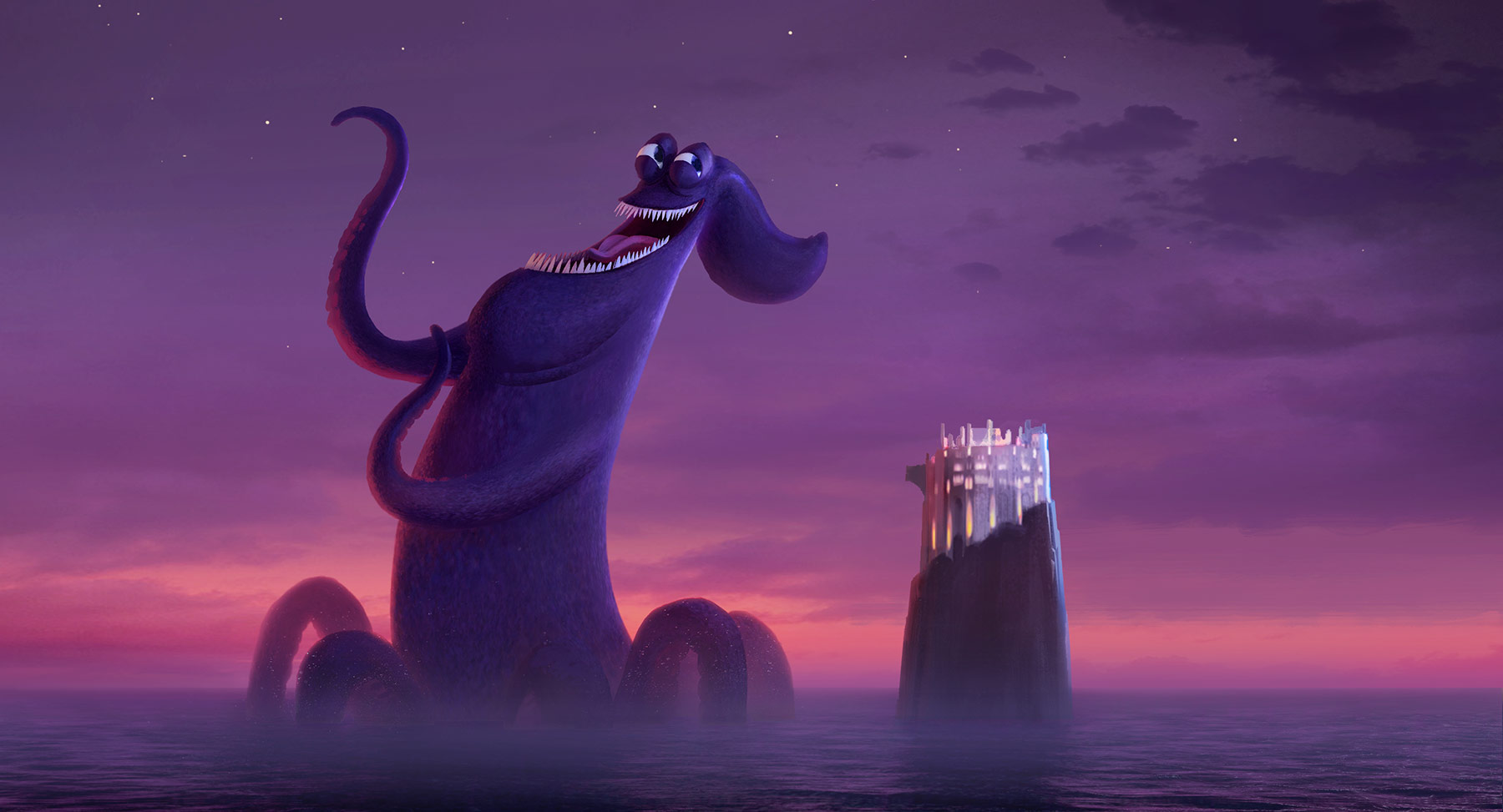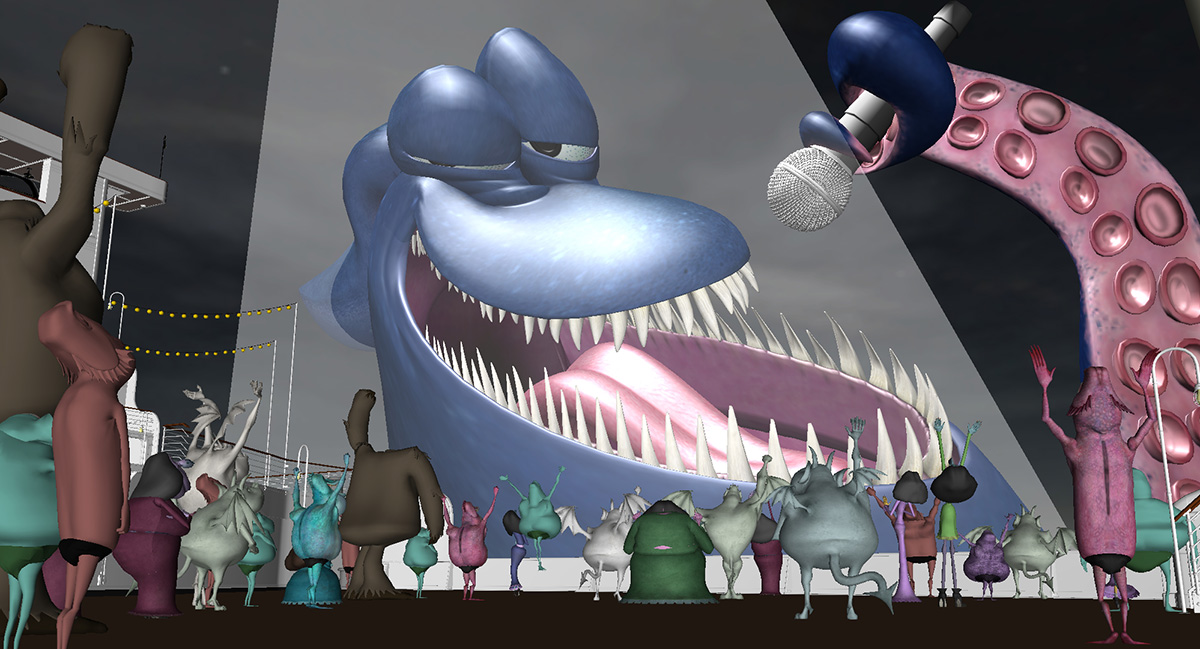

How Did They Actually Animate The ‘Hotel Transylvania 3’ Characters?
By their very nature, the Hotel Transylvania films have a lot of different characters. And since they range from humans to monsters and other creatures, each character tends to have its own attributes.
But how are those attributes brought to life on screen? Cartoon Brew asked Sony Pictures Imageworks animation supervisor Alan Hawkins how three different characters in the new Hotel Transylvania 3: Summer Vacation, the latest film in the Hotel Transylvania franchise from director Genndy Tartakovsky and Sony Pictures Animation, went from script to design to their final form, and what that means practically for the animators.
These character challenges relate to the green blob monster, Blobby (which was actually voiced by Tartakovsky), Count Dracula’s rapid bat transformations, and a brand new character, the giant sea monster Kraken (voiced by Joe Jonas).
Building Blobby
Blobby is a gelatinous monster, and so is not only translucent but also capable of forming several shapes. But one of the most unusual animation challenges for Imageworks was that the character sometimes had arms and sometimes did not. “The solve for that is nothing crazy,” said Hawkins. “We just basically shrunk the arm down to be very, very small, but the challenge is that when you do that, it makes little points. But keeping it smooth where that surface is, is always kind of a challenge so that you don’t see these little pointy spikes sticking out of him because everything else is moving around it but that piece stays rigid because of the size of it.”


Blobby’s ‘blobby’ nature also required, after animation, an effects pass in order to add in secondary jiggle. “There’s a little back and forth there where they add secondary jiggle, but their methods are usually uniform where it does the jiggle on the whole character’s body and it separates the hand from something that’s supposed to be holding because it’s jiggling,” explained Hawkins. “And so, they isolate it and it’s just the torso that jiggles and not the hand. He also has a lot of bubbles in him that we have to make sure stay inside of the body, which is kind of a weird problem, because they don’t always follow what the edge, or the outside border of the mesh, does.”
“Mostly,” added Hawkins, “it’s about just keeping him round and squishy. It’s a fun character to animate because sometimes he’s mindless like a jellyfish, and sometimes he’s motivated. So it was fun to walk that balance of how much to show in his eyes. And then there’s Baby Blobby and the Doggy Blobby. The blobby universe is always expanding.”

Drac into bat
In each film, Count Dracula’s transformations into a flying bat have been handled in Tartakovsky’s cartoony manner that emphasizes squash and stretch. That continued with Hotel Transylvania 3. The director’s other requirement was that at no point in the transition should the character look like it is ‘half and half.’
“He would never want to have a frame or certainly anything longer than that where there would be bat nose, bat ears, human eyes, anything like layered in between,” said Hawkins. “So you could do bat head, and human body for a frame, but there had to be a hard line.”

On top of that transition is typically an effects pass with sparkles and smoky purple effects. Ultimately, animators at Imageworks keep the transformations incredibly fast. There are two rigs for Dracula as a vampire and Dracula as a bat, and they animate the transition.
“The cape will close a little bit, Drac’s shape becomes a little more simplified for a frame or two, and he becomes more like a streak or a shape,” said Hawkins. “And then we’ll layer the bat posing with the wings on top of the cape area, so they have a similar silhouette. And you just transfer the energy of whatever Drac’s body was doing into the bat wings. Maybe you squash down with the closed cape, and then you elongate for a little stretch, and then the wings sort of pop out from there. Just having some kind of a cool transfer of energy into that bat motion is the key thing.”

Meet Kraken
While Blobby and the bat transitions have been seen in the two previous films, the giant tentacled Kraken is introduced in Summer Vacation. The ‘biggest’ challenge for Hawkins’ team was simply Kraken’s scale.
“He’s massive compared to everything else in that world,” the animation supervisor said. “But there’s this weird thing in Maya where the further you get from the origin from the center of the universe, things start to break and fall apart and I don’t know why that is, but they call it the circle of goodness.”

The result can be that cloth simulations and water simulations can break, especially when such a large character needs to move at what seems normal speed, but is actually mach speeds. “The Kraken is so big that you can easily move a tentacle a little bit and it will come out of the circle of goodness,” said Hawkins. “It’s mostly at the end when the Kraken is crushing rocks and they’re landing with huge splashes of water. It was mostly stuff that was solved by the effects department.”

Another challenge: Kraken’s mouth. It was able to expand and compress in a variety of ways and, says Hawkins, was almost like a character itself. “We had to work out, where does all that geometry go when you open those shapes up so much?”

As for the Kraken’s body, Imageworks actually developed two different rigs for the creature since he is first seen as really only a head and tentacles, and then later in full form. “Our second one had a whole torso just for a couple of scenes,” said Hawkins. “And then we had some other tricks – because you don’t always see the connection of the tentacles to the body, we had separate tentacles that would just be available to use wherever you want. They were a separate character, so you could have the Kraken’s face here, and then just the tentacle right there. You didn’t have to worry about how they connect because they’re totally different rigs.”
Hotel Transylvania 3: Summer Vacation opens in U.S. theaters on Friday, July 13.





.png)